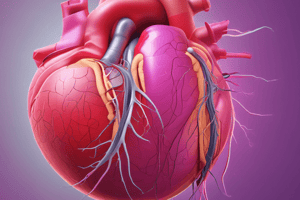Podcast
Questions and Answers
ما هي البنية التي تحتوي على القلب وتلعب دورًا حماية حوله؟
ما هي البنية التي تحتوي على القلب وتلعب دورًا حماية حوله؟
ما هو مصطلح يصف الحالة التي يُصاب فيها التأمين بالتهاب؟
ما هو مصطلح يصف الحالة التي يُصاب فيها التأمين بالتهاب؟
ما هو نوع التهاب التأمين الذي يستمر لفترة تزيد عن ثلاثة أشهر ويتطلب علاجًا مستمرًا؟
ما هو نوع التهاب التأمين الذي يستمر لفترة تزيد عن ثلاثة أشهر ويتطلب علاجًا مستمرًا؟
ما هو العامل الذي يُمكن أن يُحدث التهابًا في التأمين؟
ما هو العامل الذي يُمكن أن يُحدث التهابًا في التأمين؟
Signup and view all the answers
أي من الأعراض التالية لا يُعتبر من أعراض التهاب التأمين؟
أي من الأعراض التالية لا يُعتبر من أعراض التهاب التأمين؟
Signup and view all the answers
ما هو التصنيف الذي يستخدم لوصف التهاب التأمين الذي يُظهر تحسُّنًا في غضون أسابيع أو أشهر؟
ما هو التصنيف الذي يستخدم لوصف التهاب التأمين الذي يُظهر تحسُّنًا في غضون أسابيع أو أشهر؟
Signup and view all the answers
ما هو الاختبار الذي يستخدم الأمواج الصوتية لإنشاء صور للبطينات والصمامات والأوعية في القلب؟
ما هو الاختبار الذي يستخدم الأمواج الصوتية لإنشاء صور للبطينات والصمامات والأوعية في القلب؟
Signup and view all the answers
ما هو الفحص الذي يقوم فيه الطبيب بإزالة عينة صغيرة من أنسجة الغشاء القلبي للاختبار؟
ما هو الفحص الذي يقوم فيه الطبيب بإزالة عينة صغيرة من أنسجة الغشاء القلبي للاختبار؟
Signup and view all the answers
ما هو أحد خيارات علاج التهاب الغشاء القلبي؟
ما هو أحد خيارات علاج التهاب الغشاء القلبي؟
Signup and view all the answers
ما هو تشخيص التهاب الغشاء القلبي؟
ما هو تشخيص التهاب الغشاء القلبي؟
Signup and view all the answers
ما هو العلاج المشترك لحالات التهاب الغشاء القلبي؟
ما هو العلاج المشترك لحالات التهاب الغشاء القلبي؟
Signup and view all the answers
Study Notes
Cardiac Disorders: Understanding Pericarditis
The heart is responsible for pumping blood throughout our bodies and is encased by tissue called the pericardium. This sac-like structure contains fluid and serves as a protective barrier around the heart. When something goes wrong with this tissue, it can lead to various cardiac disorders, including one known as pericarditis. In this article, we will explore what pericarditis is, its causes, symptoms, and treatments.
What Is Pericarditis?
Pericarditis occurs when the pericardium becomes inflamed. It can cause chest pain and other related issues. There are two main types of pericarditis: acute and chronic. Acute pericarditis usually improves within weeks or months, while chronic pericarditis lasts longer—often more than three months—and requires ongoing treatment.
Causes of Pericarditis
Infections, such as viral or bacterial infections, can trigger pericarditis. Other potential triggers include conditions like tuberculosis or fungal diseases, autoimmune diseases, cancer, kidney failure, certain medications, heart problems, trauma to the chest area, and even some surgeries involving the lungs or esophagus. Sometimes, however, the exact cause of pericarditis cannot be determined despite thorough investigation.
Symptoms of Pericarditis
Symptoms of pericarditis include sharp, stabbing chest pain that often worsens upon deep breathing, coughing, lying down, or swallowing, fever, shortness of breath, fatigue, and cough. If you experience any combination of these symptoms, consult your doctor immediately.
Diagnosing Pericarditis
To diagnose pericarditis, doctors will perform a physical examination and ask about your medical history. They may also order tests such as an electrocardiogram (ECG), which measures the electrical activity in your heart; an echocardiogram, which uses sound waves to create images of your heart's chambers, valves, and vessels; and a chest X-ray to check for signs of infection, fluid buildup, or tumors. Biopsy, where a small sample of pericardial tissue is removed for testing, might also be done if necessary.
Treatment Options for Pericarditis
Treatment for pericarditis depends on the underlying cause and severity of the condition. For severe cases, hospitalization may be required, particularly if there's effusion (fluid accumulation) inside the pericardial cavity. Common treatment options include medication to reduce inflammation and pain, rest, limiting physical activities, and monitoring the condition through periodic follow-ups with your healthcare provider.
Conclusion
Pericarditis is a complex disorder that can affect individuals differently depending on their unique health situation. It's essential to seek professional medical attention if you suspect you have pericarditis to receive accurate diagnosis and appropriate treatment. Remember, early intervention can help minimize complications and improve quality of life for those affected by this disorder.
Studying That Suits You
Use AI to generate personalized quizzes and flashcards to suit your learning preferences.
Description
Explore what pericarditis is, its causes, symptoms, and treatments, including acute and chronic forms. Learn about the diagnosis methods and treatment options for this cardiac disorder.



